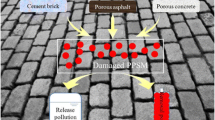Abstract
A hydrocyclone using natural water head provided by bridge was operated for the treatment of stormwater runoff. The hydrocyclone was automatically controlled using electronic valve which is connected to a pressure meter. Normally the hydrocyclone was open during dry days, but it was closed after the capture of the first flush. The results indicated that the average pressure and the flow rate were directly affected by the rainfall intensity. The pressure head was more than 2 m when the rainfall intensity was above 5 mm·h−1. The percentage volume of underflow with high solids concentration decreased as the pressure and flow rate increased, but the percentage volume of overflow with almost no solids showed the opposite behavior. The total suspended solids (TSS) concentration ratio between the overflow and inflow (TSSover/TSSin) decreased as a function of the operational pressure, while the corresponding ratio of underflow to inflow (TSSunder/TSSin) increased. The TSS separation efficiency was evaluated based on a mass balance. It ranged from 25% to 99% with the pressure head ranging from 1.4 to 9.7 m, and it was proportional to pressure and flow rate. Normally, the efficiency was more than 50% when the pressure was higher than 2 m. The analysis of the water budget indicated that around 13% of the total runoff was captured by the hydrocyclone as a first flush, and this runoff was separated as underflow and overflow with the respective percentage volumes of 29% and 71%. The pollutants budget was also examined based on a mass balance. The results showed that the percentage of TSS, chemical oxygen demand (COD), total nitrogen (TN), and total phosphorus (TP) in underflow were 73%, 59%, 7.6%, and 49%, respectively. Thus, it can be concluded that the hydrocyclone worked well. It separated the first flush as solids-concentrated underflow and solids-absent overflow, and effectively reduced the runoff volume needing further treatment. Finally, four types of optional post treatment design are presented and compared.
Similar content being viewed by others
References
Shutes R B E, Revitt D M, Lagerberg I M, Barraud V C. The design of vegetative constructed wetlands for the treatment of highway runoff. Science of the Total Environment, 1999, 235(1–3): 189–197
Kayhanian M, Suverkropp C, Ruby A, Tsay K. Characterization and prediction of highway runoff constituent event mean concentration. Journal of Environmental Management, 2007, 85(2): 279–295
Terzakis S, Fountoulakis M S, Georgaki I, Albantakis D, Sabathianakis I, Karathanasis A D, Kalogerakis N, Manios T. Constructed wetlands treating highway runoff in the central Mediterranean region. Chemosphere, 2008, 72(2): 141–149
Furumai H, Balmer H, Boller M. Dynamic behavior of suspended pollutants and particle size distribution in highway runoff. Water Science & Technology 2002, 46(11–12): 413–418
Ellis J B. The contribution of highway surfaces to urban stormwater sediments and metal loadings. Science of the Total Environment, 1987, 59: 339–349
Sriyaraj K, Shutes R B. An assessment of the impact of motorway runoff on a pond, wetland and stream. Environment International, 2001, 26(5–6): 433–439
Crabtree B, Moy F, Whitehead M, Roe A. Monitoring pollutants in highway runoff. Water and Environmental Journal, 2006, 20(4): 287–294
Sansalone J J, Cristina C M. First flush concepts for suspended and dissolved solids in small impervious watersheds. Journal of Environmental Engineering, 2004, 130(11): 1301–1314
Kang J H, Kayhanian M, Stenstrom MK. Predicting the existence of stormwater first flush from the time of concentration. Water Research, 2008, 42(1–2): 220–228
Kim L H, Kayhanian M, Zoh K D, Stenstrom M K. Modeling of highway stormwater runoff. Science of the Total Environment, 2005, 348(1–3): 1–18
U.S. Environmental Protection Agency. Storm Water Technology Fact Sheet: Hydrodynamic Hydrocyclones. EPA 835-F-99-017. Washington, USA: Office of Water, 1999
Yu J, Yi Q, Kim Y, Tateda M. Analysis of hydrocyclone behaviors in the separation of particulates from highway rainfall runoff. Water Science & Technology, 2010, 62(3): 532–540
Villeneuve J P, Gaume E, Michaud F. Efficiency evaluation of an installed swirl separator. Canadian Journal of Civil Engineering, 1994, 21(6): 924–930
Konieek Z, Pryl K, Suchanek M. Practical applications of vortex flow separators in the Czech Republic. Water Science & Technology, 1996, 33(9): 253–260
Andoh R Y G, Faram M G, Stephenson A G, Kane A. A novel integrated system for stormwater management. In: Novatech 2001: 4th International Conference on Innovative Technologies in Urban Storm Drainage, Lyon, France. Lyon: Novatech, 2001, 433–440
Rietema K. Performance and design of hydrocyclones-IV: design of hydrocyclones. Chemical Engineering Science, 1961, 15(3–4): 320–325
American Public Health Association (APHA), American Water Works Association (AWWA), Water Environment Federation (WEF). Standard Methods for the Examination of Water and Wastewater. 19th ed. Washington: APHA, 1995
Davis A P, McCuen R H. Stormwater Management for Smart Growth. New York: Springer, 2005
U.S. Environmental Protection Agency. The Quality of Our Nation’s Waters, EPA 841-S-00-001. Washington, USA: Office of Water, 2000
Castilho L R, Medronho R A. A simple procedure for design and performance prediction of Bradley and rietema hydrocyclones. Minerals Engineering, 2000, 13(2): 183–191
Lawson T B. Fundamentals of Aquaculture Engineering. New York: Champman & Hall, 1995
Puprasert C, Hebrard G, Lopez L, Aurelle Y. Potential of using hydrocyclone and hydrocyclone equipped with grit pot as a pre-treatment in runoff water treatment. Chemical Engineering and Processing, 2004, 43(1): 67–83
Author information
Authors and Affiliations
Corresponding author
Rights and permissions
About this article
Cite this article
Yu, J., Kim, Y. & Kim, Y. Removal of non-point pollutants from bridge runoff by a hydrocyclone using natural water head. Front. Environ. Sci. Eng. 7, 886–895 (2013). https://doi.org/10.1007/s11783-012-0449-0
Received:
Accepted:
Published:
Issue Date:
DOI: https://doi.org/10.1007/s11783-012-0449-0




